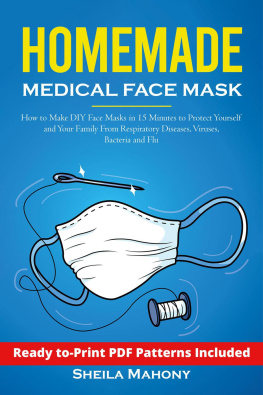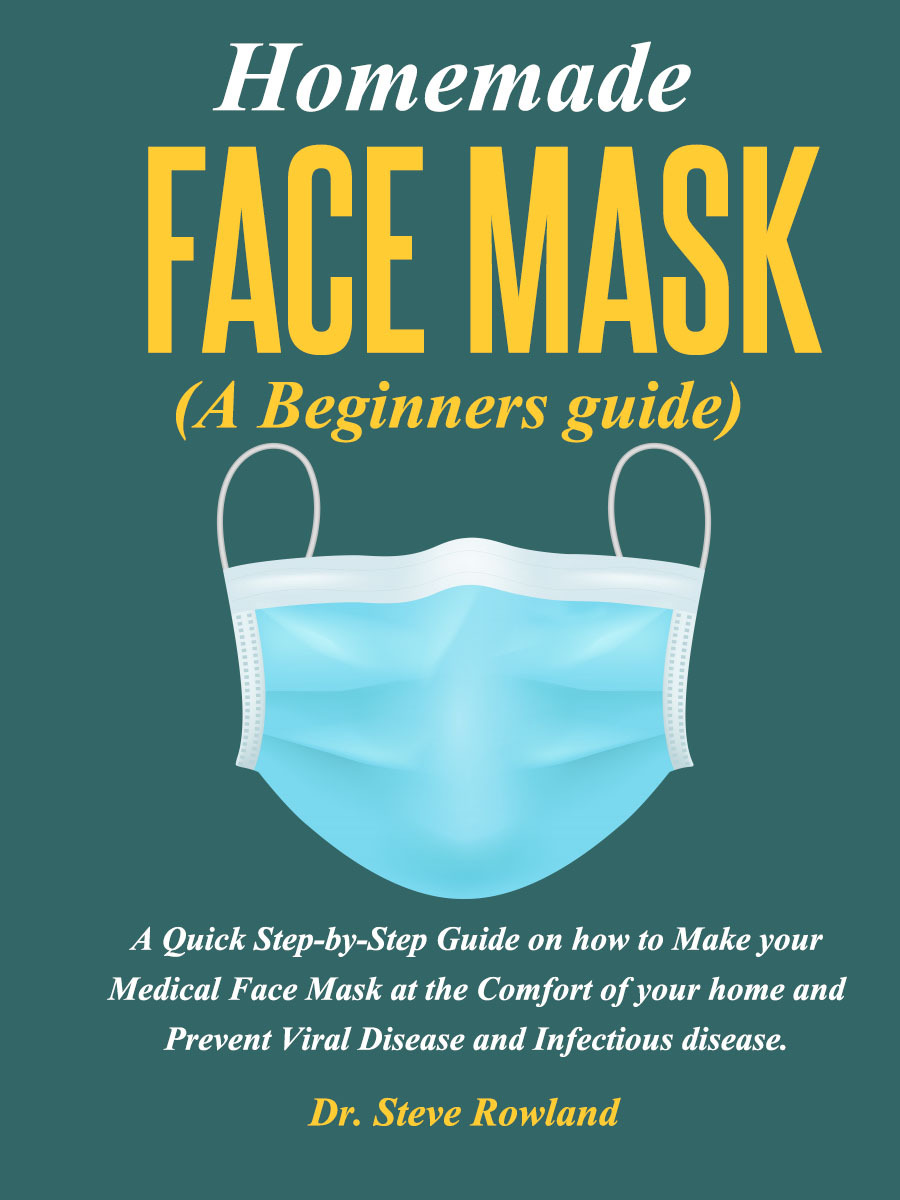Homemade
FACE
MASK
(A Beginners guide)
A Quick Step-by-Step Guide on how to Make your Medical Face Mask at the Comfort of your home and Prevent Viral Disease and Infectious disease.
By
Dr. Steve Rowland
Copyright 2020 by: Dr. Steve Rowland
All right reserved no part of this publication may be reproduced in any form or by any means, including scanning, photocopy, or otherwise without prior written permission of the copyright holder.
The information provided in this book is designed to provide helpful information on the subject discussed. The publisher and author are not responsible for any specific health or allergy needs that may require medical supervision and are not liable for any damages or negative consequences from any treatment, action, application or preparation to any person reading or following the information in this book.
Table of Contents
Introduction
Face masks (Medical) for healthcare workers are dangerously depleting due to the rapid increase in COVID-19 patients filling hospitals and the fact that many consumers are purchasing personal protective equipment (PPE) for their own personal use. Hospitals request donations of N95 respirators (i.e. CDC-recommended masks for healthcare professionals working with infectious patients). However, these efforts are not enough to keep up with the demand for N95 masks, so companies and good Samaritans take it upon themselves to sew masks for nurses, doctors, and other health care providers working on the front lines of the new coronavirus.
Nevertheless, the PPE supply has become such a crisis that hospital workers are turning to social media to order hand-sewn surgical masks. YouTube channels, Facebook groups, and Instagram accounts are popping up with bands of artisans to discover how to make homemade masks and place them in the hands of healthcare professionals. Indeed, if you have a sewing machine, you can join this movement, but first you need to know some important facts.
Furthermore, the Good Housekeeping Institute Textiles Lab contacted medical professionals, sewing experts, and fabric suppliers to gather everything you need to know about making face masks at home, from sewing tutorials to hospital guidelines.
Meanwhile, for the past few months, public health officials have advised that healthy people should not wear masks to protect themselves from the coronavirus. As we learn more about the virus, more experts challenge official guidance and say there is probably some benefit in covering our faces in public.
Recently, commercially made masks are practically impossible to find. It is observed that many people have hoarded masks in recent months, and everyone agrees that any available supply of medical masks should be reserved for hospitals and emergency workers. It entail that if you want a mask, you probably have to do it yourself.
Shan Soe-Lin, lecturer at the Yale Jackson Institute for Global Affairs, co-author of a widely shared article on the need to cover your face. "Cover your face well from your mouth to your nose to prevent large aerosol droplets from coming out or going in."
German Medical Association suggested that citizens find or make a simple cloth mask when they go out to the public and leave medical-grade masks for front-line workers. In Austria, supermarket buyers must now wear masks. Governor Andrew M. Cuomo (New York governor) has advised anyone over the age of 70 to wear a mask.
The most expensive and highest quality medical masks, called N95 respiratory masks, should be reserved for hospital and emergency service workers who are regularly exposed to high viral loads from infected patients, both by frequent contact and by medical procedures that can shed tiny viral particles in the air. In fact, the rest of us don't need that level of protection.
However, if you are not a healthcare professional and have a stash of N95 masks or standard surgical masks, consider donating it to a hospital.
If you stay home and no one in your family is infected, you don't need a mask most of the time. Nevertheless, more experts now say that wearing a non-medical or homemade mask to go to the supermarket or pharmacy can be a good idea. The studies of the use of masks to prevent the spread of respiratory diseases, including SARS, another form of coronavirus, show that a simple mask can reduce the risk of infection. The impact is much when masks are used in conjunction with hand hygiene and social distancing.
"I think the large amount of data clearly state that coronavirus is an airborne infection carried by respiratory droplets, and can also be transmitted by direct contact with an infectious person," said Dr. Siddhartha Mukherjee, assistant professor of medicine at Columbia University, who recently wrote an article on how coronavirus behaves within patients. "The face mask works in two ways: not only to protect you from me, but also from you."
Finally, while we don't have much research on the effectiveness of homemade masks in preventing the spread of infection, scientists studying airborne diseases can offer some guidance. In fact, face mask sewn from a pattern or a makeshift facial cover made from a T-shirt probably offers some protection. It is revealed that the thicker the fabric, the better: think of a thick cotton T-shirt or a thick, felt-like fabric, said Linsey Marr, a Virginia Tech scientist and expert in airborne virus transmission. While some people have suggested wearing a bandanna, the fabric is usually so thin and flimsy that it is likely to offer little protection. Fold or triple the fabric of the bandanna if that's all you have.
The effectiveness of homemade masks
A study in 2013 looking at the ability of homemade masks made from cotton jersey material to prevent the spread of influenza found that they were approximately one-third as effective as surgical masks, but still "significantly reduced the amount of microorganisms expelled by the volunteers. "In this study it is not clear how effectively the masks protected people from breathing in particles that could contain a virus.
It's very important to save N95 respirators for medical professionals caring for patients with COVID-19, the illness caused by the coronavirus, said Joyce Fulton, a registered nurse. However, Fulton is helping to organize people to make masks for the general public in hopes of releasing more supplies for medical professionals.
"People who would normally wear a mask, such as immune-compromised people, cancer patients going to their chemotherapy appointments, or older people going to grocery shop, can wear these masks instead of using N95n once," she said.
How to make an effective face mask
However, y ou can make a homemade face mask regardless of whether you're able to sew. Remember, many items you have around the house can filter out air particles and could reduce your exposure to the virus.
Layers are key to making an effective mask said Nasseri. It is also essential that the mask forms a tight seal over the mouth and nose so that particles do not enter through the gaps.
"Face Masks with a silky outer layer (if possible), an intermediate layer of a thick, well-woven material like nylon or cotton, and then a comfortable cotton inside are ideal," he said. You are to kip wool or other fabrics that can cause allergies or irritate your skin.
However, there are many free patterns for sewing a mask. Few of the healthcare organizations have published guidelines, and some stores, including JoAnn Fabrics, offer free precut materials to people who sew face masks at home. In fact, you can even sew a face mask lined with a vacuum filter, which some say might be more effective at filtering out particles.




